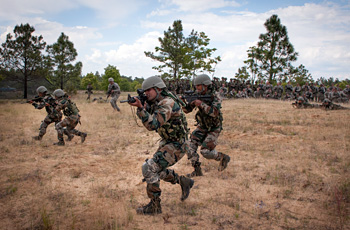INDIAN ARMED FORCES CHIEFS ON OUR RELENTLESS AND FOCUSED PUBLISHING EFFORTS

The insightful articles, inspiring narrations and analytical perspectives presented by the Editorial Team, establish an alluring connect with the reader. My compliments and best wishes to SP Guide Publications.

"Over the past 60 years, the growth of SP Guide Publications has mirrored the rising stature of Indian Navy. Its well-researched and informative magazines on Defence and Aerospace sector have served to shape an educated opinion of our military personnel, policy makers and the public alike. I wish SP's Publication team continued success, fair winds and following seas in all future endeavour!"

Since, its inception in 1964, SP Guide Publications has consistently demonstrated commitment to high-quality journalism in the aerospace and defence sectors, earning a well-deserved reputation as Asia's largest media house in this domain. I wish SP Guide Publications continued success in its pursuit of excellence.
- Appointments Committee of Cabinet approves one-month extension in service of Chief of the Army Staff
- Admiral Dinesh K. Tripathi assumes Command of the Indian Navy as 26th Chief of the Naval Staff
- Prime Minister witnesses 'Bharat Shakti' – a Tri-Services Firing and Manoeuvre Exercise in Pokhran, Rajasthan
- Interim Defence Budget 2024-25 — An Analysis
- Union Defence budget 2024
- Prime Minister Modi Commemorates Indian Navy Day in a Grand Ceremony
Soldiers demand One Rank, One Pension

When a former service officer writes on a subject which involves ex-servicemen’s benefits he is unlikely to be taken seriously because he is expected to take the side of his former comrades in arms! However, notwithstanding the skeptical view that my brief write-up is likely to invite, what differentiates this issue of ‘One Rank, One Pension’ (OROP) from other issues is that it highlights the sheer neglect of the ex-servicemen over the decades since independence by successive governments. Therefore let us understand what is driving the OROP. Is it merely the money drawn as pensions drawn by our soldiers who retire relatively early, i.e. by about 35 to 37 years of age when the family liabilities are the greatest or is it the sheer frustration that they have been deliberately done down by successive governments in terms of pensions and izzat. Perhaps this is the main reason for this anger and dismay.
The military by and large has preferred a BJP-led Government who is seen to be more sympathetic to their cause being a self-proclaimed nationalistic government as compared to the Congress-led governments. Moreover this time Prime Minister Narendra Modi had made it very clear before the elections that his government would grant OROP to the veterans if they came to power. Thus the delay in implementing the scheme is all the more disturbing.
The widely touted argument against OROP to the military veteran is the likelihood of a similar demand being raised by other uniformed services like BSF, CRPF, etc. But this is a red herring and a fallacious argument because unlike bureaucrats and paramilitary forces who all serve till 60 years of age, most military soldiers retire at 35-37 years of age, while officers below brigadier or equivalent do so at 54. We retire soldiers early to keep the army young and physically fit. Hence it stands to reason that they must be compensated adequately. This fact is so simple that it needs no further explanation.
There are many other startling facts which have emerged lately such as the ‘non-functional upgrade’ (NFU) to officers in all-India Group A services. This is a sort of ‘pay-promotion’ allowing them to draw higher pay than their rank under certain conditions. Almost all civil servants benefit from this while defence services officers do not. NFU is a sort of ‘OROP by backdoor for civil servants’.
In all other democracies the soldiers have a better structure of salaries and special allowances. American soldiers have a 15-20 per cent edge over other government employees, British 10 per cent, Japanese 12-29 per cent and French soldiers 15 per cent. In pensions, while Indian soldiers get 50 per cent of their last pay per month, American soldiers get 50-75 per cent, Australian 76.5 per cent, Japanese 70 per cent and French soldiers 75 per cent.*
The Indian military still carries the traditions of the UK military. The UK has embraced OROP for soldiers. Other countries also compensate their military for its services. It is in keeping with this tradition that all Standing Committees of Parliament and the Courts in India have upheld the demand for One Rank, One Pension.
* ‘The Soldiers Right’, Times of India, June 16, 2015





